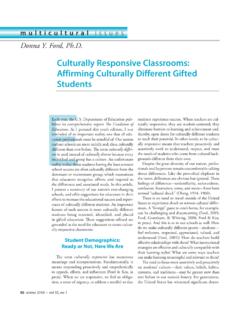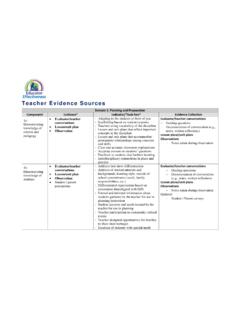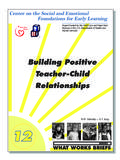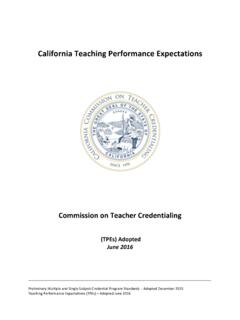Transcription of March 2019 Culturally Responsive Teaching
1 March 2019 Culturally ResponsiveTeachingA 50-State Survey of Teaching StandardsJenny Mu iz Last edited on March 28, 2019 at 9:00 EDTA cknowledgmentsThis report benefited from the invaluable expertiseand editorial insight of New America colleaguesSabrina Detlef, Amaya Garcia, Elena Silva, andMelissa Tooley. Special thanks to Alexandra Manueland Saroja Warner for reviewing drafts of the you to the many state leaders who generouslyshared information about their state s teachingstandards. And particular thanks go to EmmaColeman, Riker Pasterkiewicz, and Maria Elkin forlayout and communication support. New America sPreK 12 team is generously supported by the Bill &Melinda Gates Foundation, the Heising-SimonsFoundation, the Hewlett Foundation, the Foundation, the McKnight Foundation, andthe W.
2 Clement and Jessie V. Stone Foundation. Theviews expressed in this report are those of its authoralone and do not necessarily reflect the views ofthese foundations. If you have any questions aboutthis report, please contact the Author(s)Jenny Mu iz is a program associate with theEducation Policy program at New America. She is amember of the English learner education team,where she provides research and analysis on policiesand practices related to English learners, culturallyresponsive education, and educational New AmericaWe are dedicated to renewing America by continuingthe quest to realize our nation s highest ideals,honestly confronting the challenges caused by rapidtechnological and social change, and seizing theopportunities those changes create.
3 About Education PolicyWe use original research and policy analysis to helpsolve the nation s critical education problems,crafting objective analyses and suggesting new ideasfor policymakers, educators, and the public at large. IntroductionUnderstanding Culturally Responsive TeachingWhat is Culturally Responsive Teaching ?What Does Research Say About Culturally Responsive Teaching ?Who is Culturally Responsive Teaching for? teacher Competencies that Promote Culturally Responsive TeachingUsing Professional Teaching Standards to Promote Culturally ResponsiveTeachingCulturally Responsive Teaching in National ModelsFreestanding Culturally Responsive Teaching StandardsProfessional Standards and AlignmentIntegration of CRT in State Professional Teaching StandardsGathering and Analyzing StandardsFindings: Culturally Responsive Teaching Competencies Across StatesExcerpts from Excellent Teaching Standards Cont'dConclusions and RecommendationsAppendix A: MethodologyAppendix B.
4 Overview of State Teaching the first time in our history, students of color make up the majority ofstudents enrolled in public schools. Yet 65 years after Brown tried to pave afair path for these students, the promise of educational equity remains many students of color are languishing in under-resourced schools, wherethey lack access to high-level academic courses, enrichment opportunities,quality materials, and adequate facilities. These resource inequities only beginto scratch the surface, however. It is also the case that too many students of colorare held to lower academic standards, subjected to harsh discipline approaches,and taught in ways that overlook or discount their cultural and linguistic and other barriers give way to massive imbalances in academicperformance that serve to limit students' life a diverse pool of educators who are prepared to demonstrate culturallyresponsive Teaching or relevant Teaching (herein CRT) is critical to reversingunderachievement and unlocking the potential of students of color as well as thatof other groups of underserved learners.
5 Culturally Responsive Teaching is anapproach that challenges educators to recognize that, rather than deficits,students bring strengths into the classroom that should be leveraged to makelearning experiences more relevant to and effective for them. Adopting CRT goesbeyond celebrating students cultural traditions once a year. Educators whopractice CRT set rigorous learning objectives for all of their students and theycontinually build helpful bridges between what students need to learn and theirheritage, lived realities, and the issues they care about. In short, culturallyresponsive Teaching is about weaving together rigor and is needed now is a major investment indeveloping Culturally Responsive educators, onethat goes beyond providing one-off courses need for Culturally Responsive Teaching is more pressing than ever before,especially when you consider the deep demographic gaps between teachers andstudents.
6 A Teaching workforce that remains overwhelmingly female, white,middle-class, and monolingual is increasingly likely to teach students who are ofa different race, ethnicity, socio-economic status, language group, and so are the drivers of Culturally Responsive practices in schools andclassrooms. But without the appropriate training and support, even the mostwell-meaning teachers can unwittingly provide instruction that is irrelevant,ineffective, and even antagonistic to today s diverse learners. Researchconcludes that recruiting a more racially diverse Teaching workforce candramatically improve cultural responsiveness in schools, but demographicparity is unlikely to be achieved in the coming years.
7 Therefore, all teachers,regardless of background, benefit from support in reaching the diverse learnersthey are likely to , teacher preparation programs and professional developmentsystems across the country are not sufficiently preparing educators to bring CRTto life in the classroom. Consider: while some educator preparation programs arenow required to offer coursework on Teaching diverse students, these coursesare often narrow and disconnected from the mainstream curriculum. In-servicesupport and development fall short as well, as confirmed by teachers instance, a 2018 survey of New York City teachers conducted by theMetropolitan Center for Research on Equity and the Transformation of Schools,found that fewer than one in three teachers had received ongoing professionaldevelopment on how to address issues of race and ethnicity in the Responsive Teaching is about weavingtogether rigor and is needed now is a major investment in developing Culturally responsiveeducators.
8 One that goes beyond providing one-off courses or comprehensive professional Teaching standards that incorporateexpectations for CRT is a foundational step state leaders can take to bolster thefocus of CRT in current systems of teacher preparation and development. Notonly would such standards ensure that teachers receive clear and consistentmessaging about the knowledge, skills, and mindsets needed to be culturallyresponsive throughout their careers they would also establish CRT as a formalstate priority. Though not a panacea, comprehensive state-level professionalteaching standards offer an opportunity to send a bold message that far frombeing an "add-on" initiative, CRT is integral to the work of all quality America analyzed professional Teaching standards in all 50 states to betterunderstand whether states expectations for teachers incorporate culturallyresponsive Teaching .
9 To support this analysis, we identify eight competencies what teachers should know and be able to do in light of research onculturally Responsive Teaching . Our research finds that while all states alreadyincorporate some aspects of Culturally Responsive Teaching within theirprofessional Teaching standards, the majority of states do not yet provide adescription of Culturally Responsive Teaching that is clear or comprehensiveenough to support teachers in developing and strengthening their CRT practicethroughout their careers. As an added resource, we have assembled excerptsfrom state standards in which CRT is already well articulated, as well a datavisualization that describes the prevalence of CRT competencies in teachingstandards across Culturally Responsive TeachingWhile the term Culturally Responsive Teaching is gaining popularity, what thisapproach actually means often depends on who you ask.
10 Researchers have raisedconcerns that, without the proper guidance, education leaders and individualeducators can adopt simplistic views of what it means to teach in culturallyresponsive ways. Moving forward therefore requires that educators and thosewho support their efforts have a coherent understanding of what culturallyresponsive Teaching does and does not is Culturally Responsive Teaching ?Several frameworks exist for Culturally Responsive approaches ( , culturallyresponsive education, Culturally relevant Teaching , and Culturally congruentteaching), each outlining various components. Capturing the history and broadbase of scholarship on CRT is not possible here as there are decades of researchand analysis.



















